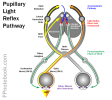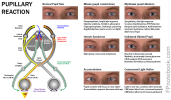II. Physiology: Pupil Constriction as a normal response
- Images
- Parasympathetic stimulation
- Parasympathetic fibers course with CN 3
- Parasympathetic fibers originate in Edinger-Westphal Nucleus and transmit to ciliary Ganglion
- Bright light results in bilateral Pupil Constriction
- Direct reaction to light in exposed eye
- Light strikes Retina of affected eye
- Signal passed via Optic Nerve to Midbrain
- CN 3 associated parasympathetic fibers signal same iris to constrict
- Consensual Light Reaction in opposite eye
- Direct reaction to light in exposed eye
- Accommodation
- Visual focusing
- Near Reaction (e.g. Reading)
- Also results in eye convergence (under CN 3 control as well)
- Near Reaction (e.g. Reading)
- Pathway
- Ciliary body Smooth Muscle contracts
- Lens changes shape (more convex)
- Pupil constricts during accommodation to aid focusing
- Both ciliary body contraction and Pupil Constriction are mediated by CN 3 related parasympathetic fibers
- Visual cortex controls accommodation as part of a reflex loop based on Optic Nerve signals
- Visual focusing
III. Causes: Abnormal Miosis
- Horner's Syndrome
- Mnemonic: COPS
- Cholinergic Toxicity
- Clonidine
- Opioids (e.g. Heroin, Morphine)
- Organophosphate Toxicity
- Phenothiazines
- Pilocarpine
- Pontine bleed or lesion
- Sedative-Hypnotics (e.g. Benzodiazepines)
- Pinpoint Pupils (Miosis) AND respiratory depression, Altered Mental Status and Bradycardia
- Pontine Hemorrhage
- Organophosphate Poisoning
- Imidazoline Poisoning
- Clonidine Overdose (including Clonidine patch)
- Child ingestion of topicals: Oxymetazoline (Afrin), Naphazoline (Visine)
- Dexmedotomidine (e.g. veterinary Anxiolytic medications)
IV. Causes: Other Abnormalities
-
Syphilitic Pupil (Argyll-Robertson Pupil, Prostitute's Pupil)
- See Neurosyphilis
- Mnemonic (Prostitute's Pupil): Pupil accomodates but does not react
- Pupil constricts during accommodation, but does not constrict to light
- Due to Midbrain lesion (superior colliculus, pretectal region)
- Typically bilateral lesions resulting in small, irregular pupils


